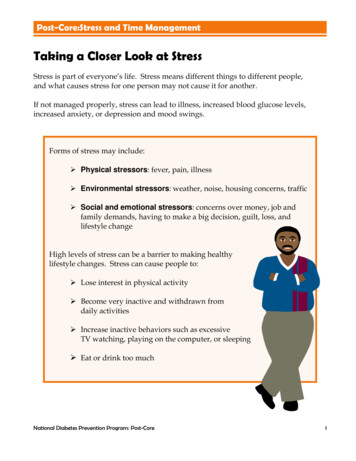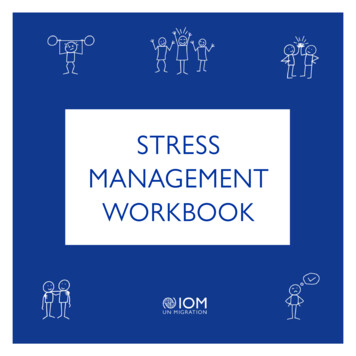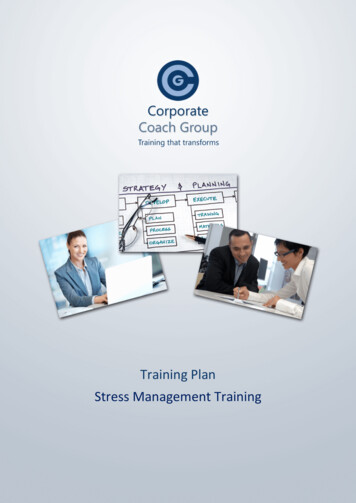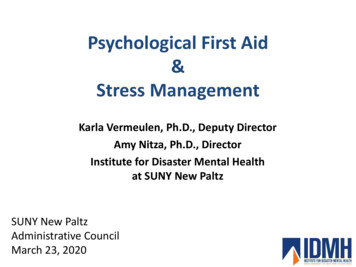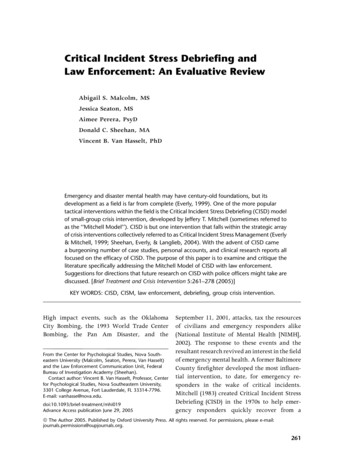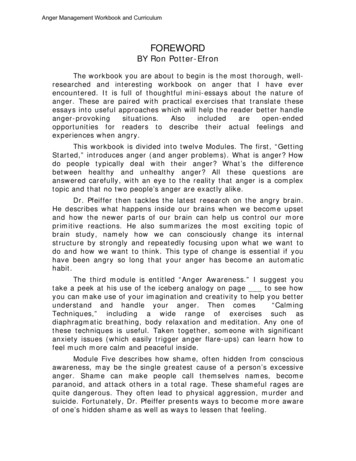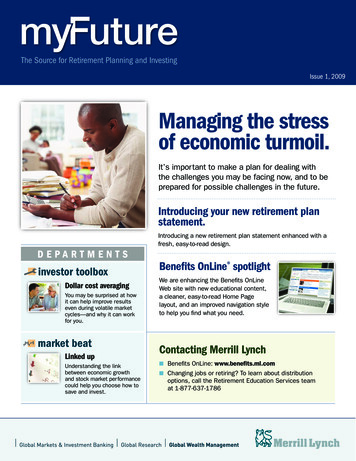
Transcription
The Source for Retirement Planning and InvestingIssue 1, 2009Managing the stressof economic turmoil.It’s important to make a plan for dealing withthe challenges you may be facing now, and to beprepared for possible challenges in the future.Introducing your new retirement planstatement.Introducing a new retirement plan statement enhanced with afresh, easy-to-read design.DEPARTMENTSinvestor toolboxDollar cost averagingmarketYoubeatmay be surprised at howit can help improve resultseven during volatile marketcycles—and why it can workfor you.Benefits OnLine spotlightWe are enhancing the Benefits OnLineWeb site with new educational content,a cleaner, easy-to-read Home Pagelayout, and an improved navigation styleto help you find what you need.investor toolboxmarket beatLinked upUnderstanding the linkbetween economic growthand stock market performancecould help you choose how tosave and invest.Contacting Merrill Lynch Benefits OnLine: www.benefits.ml.com Changing jobs or retiring? To learn about distributionoptions, call the Retirement Education Services teamat 1-877-637-1786
The Source for Retirement Planning and InvestingIssue 1, 2009 page 2Managing the stressof economic turmoilfor yourself and your family.The current economic downturn has put pressure onmillions of families. These pressures can intensifystress levels. That’s why it’s important for you andyour family to be prepared for such challenges.Create a planNo matter how the economic downturn affects you, a plan can help you getthrough these tough times. It doesn’t have to be formal. Just set aside timeto put some ideas in writing with your spouse or significant other. Here areseven steps to take as you create your plan.p1. Create a budget.Create a budget that reduces regular household expenses and eliminates nonessential spending. Review everything.Consider less expensive alternatives to name brand products or dropping or phasing out little-used services,perhaps a gym membership. Look for inexpensive or free activities and community services for yourself andyour family, maybe a family “game night” rather than a night at the movies. Check out your local public library;in addition to books, many offer children’s activities and DVDs. Focusing on family activities can have morethan financial benefits; it could bring your family closer, which could make you feel more secure in thesedifficult times.Choosing which expenses to cutWhen it comes to cost cutting, be careful of what and where you cut. A modest increase in your “deductible”on your home or car insurance—and decrease in premiums—might make sense. But your cell phone andhigh-speed Internet service can be valuable tools if you are looking for a job. If your child carries a cell phone,consider switching to a prepaid plan that will curtail text messaging and excessive calling. And avoid the urgeto skimp on important home maintenance; the cost of keeping your roof in good repair may be far less thanthe cost of replacing that roof down the line.Continued on next page.
The Source for Retirement Planning and InvestingIssue 1, 2009 page 3Continued from previous page.If you’re faced with severe hardship, you may already be considering muchlarger steps. Typically a household’s biggest recurring expense is rent ormortgage payments. You may need to consider downsizing or selling yourhome or moving to a less expensive apartment.It might even make sense to move to a new area of the country to takeadvantage of new opportunities. If you think moving might be an option,investigate the relative costs of housing in different areas and the jobopportunities they might offer. Living expenses are the highest in theNortheast and along the California coast. In the South and the Midwest,housing is considerably cheaper. Look for a region that is growing,possibly an area where state or local government has offered taxincentives to major companies to relocate. The local labor market isoften a major beneficiary in these areas.p2. Manage debts logically.Affordable communitiesThe top seven mostaffordable communitieswith population of at least500,000, according toSperling’s Best Places, 2008: Wichita, KS Omaha, NE Harrisburg, PA Madison, WI San Antonio, TX Indianapolis, IN Pittsburgh, PAOnce you’ve addressed spending, focus on your debts. To avoid serious consequences, prioritize your debtpayments and pay the most important ones first—your mortgage or rent. If you are having trouble makingpayments on credit card debt, call your card company. You may be able to negotiate a more favorable paymentschedule or a reduction in the amount you owe. But be wary of offers to consolidate debt by taking out a loan.Many of these offers involve fees and higher interest costs over time, which could make it even more difficultto get back on your feet.p3. Build an emergency fund.If you’re currently working, start an emergency fund. If you have an emergency fund, add to it. Your goalshould be to set aside enough money to cover four to six months of expenses. Make it easy to get to youremergency funds by keeping them in a savings account or money market account. Don’t tie up emergencymoney in a financial instrument that would impose a penalty for early withdrawal. Keep it liquid—don’t investin volatile investments, such as stocks or stock mutual funds.p 4. Changing jobs? Keep your savings working tax-deferred.If you lose your job or change jobs, resist the temptation to drain your retirement savings. If you “cash out,”you’ll have to pay taxes on your pre-tax contributions and any earnings, and possibly a 10% tax penalty ifyou’re under age 59½. Consider keeping your money in your current plan (if your plan allows) or rolling it overto a new employer’s plan (if available) or an IRA.If you are facing a job transition or retirement, Merrill Lynch Retirement Education Services can help youunderstand your distribution options and help you implement your choice. Call 1-877-637-1786.Continued on next page.
The Source for Retirement Planning and InvestingIssue 1, 2009 page 4Continued from previous page.p5. Be proactive in the job market.If you’ve lost your job or think you might, have a plan. Network with colleagues and friends and stay on top ofonline and community resources to help you learn about possible opportunities. A network of support can alsokeep your spirits up while you’re looking. And if you do lose your job, immediately apply for unemploymentbenefits, if eligible. Remember that you paid taxes to fund that program.Also consider opportunities for education and training. Local community colleges often offer vocational andretraining programs tailored to accommodate the schedules of older workers, and program fees are oftenvery reasonable.p6. Take care of your health.Be sure to take care of your physical and mental health. Recognize thatyou will need to deal with stress and anxiety, which can undermine yourhealth and your work performance, or hold you back if you are searchingfor a new job.You can relieve stress by eating right, exercising and getting enough sleep. Many people feel they just cannot take time to exercise with so manyimportant things to do, but resist that feeling. Make exercise a part ofyour routine.Sources of stressMoney and the state ofthe economy are two of thetop sources of stress for80 percent of Americans,according to the AmericanPsychological Association’s2008 Stress in Americasurvey. Sleep is very important to staying healthy. Cut back on caffeine, ifnecessary, and stay with a routine sleep schedule. If sleep is difficult,see your doctor. Consider carefully before dropping health insurance—an illness or injury could be financially devastating.Also be sure you continue getting routine medical and dental care. Keep your physician informed if you areworried about your job situation—job-related stress can lead to depression and anxiety. Know the signs—andget treatment before they get out of hand. A positive mental attitude can help you see past the current turmoil.It’s also one of the best things you can take with you into a job interview or employment fair.These steps are not only healthier, you’ll feel better and look better.p7. Discuss family financial plans with your children.Two generations ago few parents discussed sensitive issues with their children. Finances, in particular, weretaboo. But times have changed.Your children are likely to learn about the economy’s troubles on television, the Internet or through other media.They may also be discussing the economy and its impact on people in their classes at school. And, they mayhave overheard parts of conversations between you and your spouse. Experts agree that you should be frankContinued on next page.
The Source for Retirement Planning and InvestingIssue 1, 2009 page 5Continued from previous page.and open in discussing your family’s finances and what ishappening in the economy with your children. Be honest.Be calm. And speak in terms they can understand.Reassure your children that you have a plan of action—and enlisttheir help. Share the list of things you plan to sacrifice from yourspending and ask them to volunteer ways they can spend lessand help more around the house. By making today’s challengesa family affair, you may become closer to each other and staycloser even when times get better. Just as important, the valuesyou instill are likely to make your children more resourceful whenthey face their own challenges in the years ahead.Put yourself to the testEven if you feel you’ve already done everything you can to cut costs and limit spending, put yourself to thetest. Track all expenditures for one month and review them with your family. Look for opportunities to save alittle bit more. And, if you can avoid it, don’t add a single dollar to your household debt until you have a planfor repaying it. Once you have your economic house in order, make a pledge to be financially prepared forwhatever the future may bring. Continue to pay off your debt. Build savings that can help you weather the nextstorm. When everyone in the household is committed, it’s easier to tackle the challenges and more satisfyingto share the success.To learn more about how you can create a budget and manage your credit and debt,visit www.benefits.ml.com Advice & Planning Personal Finance.Merrill Lynch, Pierce, Fenner & Smith Incorporated is a registered broker-dealer and a wholly owned subsidiary of Bank of America Corporation.Investment products:Are Not FDIC InsuredAre Not Bank GuaranteedMay Lose ValueUnless otherwise noted, all service marks (registered or otherwise) are the property of Merrill Lynch & Co., Inc. 2009 Merrill Lynch, Pierce, Fenner & Smith Incorporated. All rights reserved.Member Securities Investor Protection Corporation (SIPC).200914060309
The Source for Retirement Planning and InvestingIssue 1, 2009 page 6Coming soon—your newretirement plan statement.Saving for your future is important. That’s why you want a retirement planstatement that’s simple, clear and concise. And that’s why our new retirementplan statement is enhanced with a fresh, easy-to-read design. We’ll implementthese changes in mid-2009.You’ll get the big picture on page oneYour statement starts with an “at-a-glance” summary of each account included in the statement. You’ll needonly a few seconds to see: Your account balance at the startof the reporting period Your ending balance Your personal rate of return forthe period Your asset allocation (how your401(k) account is invested)You’ll find additional details inside thestatement , and complete details onBenefits OnLine , the plan’s Web site.(The following illustrations are 401(k)statement pages. If you participate inother types of plans at Merrill Lynch,those plans will be reflected on yourstatement, and some pages may varyfrom those shown here.)Enhanced statements are coming soon!You’ll receive your first new statement in mid-2009.Continued on next page.
The Source for Retirement Planning and InvestingIssue 1, 2009 page 7Continued from previous page.Activity Detail sectionKeep tabs on your recent contributions and other activityThe Activity Detail section starts with “Contributions and Activity for This Period.” The page shown belowexpands the Beginning and Ending Balances from page one. You’ll find such details as: How much you (and your employer, if applicable) contributed for the reporting period and year-to-date How much you are contributing each pay period Any loan repayments and your total outstanding loan amount, if any Changes in your balance such as interest, dividends and credits, as well as withdrawals, debits and fees The aggregate increase/decrease in your assets’ market value and your personal rate of return* Other useful 401(k) informationYou can review allthe details online.Details of allaccount activityare available onBenefits OnLine at:www.benefits.ml.com* These are estimates of your investment returns based on account data for the periods listed. The estimates were calculated usinga widely accepted, time-weighted daily valuation method. The return is based on the results of your investment selections as well asaccount activity. Other methods of calculating returns may yield different results. Past performance is no guarantee of future results.Continued on next page.
The Source for Retirement Planning and InvestingIssue 1, 2009 page 8Continued from previous page.Activity Detail section (continued)Investment SummaryThis page of the Activity Detail Section provides a fund-by-fund summary of your investments, grouped by assetclass. You’ll find: Fund names and ticker symbols (if any) to help you track each fund’s performance The percentage of future contributions being invested in each fund The number of shares or units of each investment, and the price of each Your ending balance—the number of shares/units multiplied by their price Your personal informationContinued on next page.
The Source for Retirement Planning and InvestingIssue 1, 2009 page 9Continued from previous page.Fund Performance sectionYour statement will include a fund performance summary annually, including enhanced Risk/Reward graphicsto help you compare the funds offered by your plan. Funds are grouped by asset class. You’ll find: A large pie chart to help compare risk and reward characteristics for all types of funds Name and symbol (if applicable) for each fund Individual pie charts beside each fund name to show the risk/reward potential for the fund The gross expense ratio for each fund Fund performance for the quarter and year-to-date, as well as for one, five and ten years, and sinceinception (and the inception date)For the most recent Fund Performance, visit Benefits OnLine. Under the 401(k) Plan, select Investments Investment Choices & Performance Average Annual Total Returns, or for a printable version, click AccountInformation Statements.Continued on next page.
The Source for Retirement Planning and InvestingIssue 1, 2009 page 10Continued from previous page.Two ways to learn more about the statement now!Use the links below to review the “How to Read Your Statement” guide. Choose the version of the guide thatbest matches your situation, depending on whether you have a 401(k) Plan only or have a 401(k) Plan plusanother type of retirement plan.For 401(k) Plan Only: View an Interactive Guide that will take you on a tour of thenew statement. View a PDF to read at your convenience.For 401(k) Plan plus Other Plan(s): View a PDF to read at your convenience.Then watch for your new Retirement Plan statement, coming soon.Note: These guides represent features typical to retirement plans andstatements. You can review your actual statement on Benefits OnLine at www.benefits.ml.com.Review your statement and fund performance24/7 on Benefits OnLine Your newest statement and fund performance are available virtually 24/7 on Benefits OnLine, the Plan Web site. Log on to www.benefits.ml.com. For current and prior statements, under the 401(k) Plan, click Account Information Statements. A new statement will be posted following each reporting period. It may also be mailed to you atapproximately that time. To view or print the most recent Fund Performance, under the 401(k) Plan,click Account Information Statements.Merrill Lynch, Pierce, Fenner & Smith Incorporated is a registered broker-dealer and a wholly owned subsidiary of Bank of America Corporation.Investment products:Are Not FDIC InsuredAre Not Bank GuaranteedMay Lose ValueUnless otherwise noted, all service marks (registered or otherwise) are the property of Merrill Lynch & Co., Inc. 2009 Merrill Lynch, Pierce, Fenner & Smith Incorporated. All rights reserved.Member Securities Investor Protection Corporation (SIPC).200914060309
Issue 1, 2009 page 11The Source for Retirement Planning and InvestingBenefits OnLine spotlightBenefits OnLine enhancements coming soon!You’ve told us that you need more tools and information for making informed decisions, and that it should beeasier to find these resources on the Benefits OnLine Web site. That’s why we are enhancing the site—withnew educational content, a cleaner, easy-to-read Home Page layout, and an improved navigation style to helpyou find what you need.What’s not changingYou’ll still log in at www.benefits.ml.com and you’ll continue to find all your account and transaction informationin exactly the same place they’ve always been.What you’ll find on thenew Home Page1. P ortfolio Summary: Includes each of youraccount(s) and the up-to-date balance in each. sset Allocation: Provides a pie chart2. Ashowing how you’ve allocated yourinvestments.Logout Help SitemapGet Quote: Enter SymbolHomeMarkets401KInvestment HoldingsMy Accounts1.5. 4. Message Center: Offers timely informationon plan changes and related topics.6. 6. Resource Center: Presents topics of interestand facts to help you plan for the future andmanage your retirement assets.Message CenterSitemapAccount Preferences3. 3. Quick Links: Lets you set up shortcutsto your favorite pages. 5. Prominent links to the Merrill Lynch AdviceAccess service, if available in your plan.Advice & PlanningMy HomePortfolioDownload to Quicken2.Asset Allocation(Edit)Message Center4.AnnouncementsABC Company 401(k) Plan 59,000.25Total Market Value: 59,000.25Your Advice Is Ready for You Now— Select Quick Links —Roth 401(k) contributionsnow available. MoreContribution limits increasein 2009. MoreAction RequiredResource CenterAre you financially prepared?Financial preparedness has benefits at every stage of your life. Discover six things you can doto get-and keep-your financial house in order.Borrowing trouble.Let’s consider the long-term consequences of borrowing against your 401(k) balance or takinga hardship withdrawal-the cost may surprise you.Exit StrategiesIf you’re leaving your employer for a new job or for retirement, here’s what you need to knowbefore you make a decision about your retirement savings.It's not only what you're saving for . . . it's whenThere are many factors to consider when deciding how to invest for the future. Your futureincome needs, your comfort with investment risk, and the assets you have available to investare all important considerations.GO*Market values displayed may include accruals. 7. Related Links: Includes shortcuts to the Website’s frequently used pages and related siteswith just one click.7.Related LinksStatementsAdvice AccessMy Account PerformanceMerrill Lynch OnLine Merrill Lynch Direct Watch for these enhancements!Privacy StatementTerms & ConditionsCall UsE-mailGlossaryFAQsMerrill Lynch, Pierce, Fenner & Smith Incorporated is a registered broker-dealer and a wholly-owned subsidiary of Bank of America Corporation.Securities Products: Are Not FDIC Insured Are Not Bank Guaranteed May Lose Value.Merrill Lynch makes available investment products and services sponsored, managed, provided or distributed by companies that are affiliates of or inwhich Bank of America Corporation has an economic interest, including Columbia Management, BlackRock, and Nuveen Investments.Continued on next page. Copyright 2009 Merrill Lynch, Pierce, Fenner & Smith IncorporatedAll rights reserved. Member, Securities Investor Protection Corporation (SIPC).
Issue 1, 2009 page 12The Source for Retirement Planning and InvestingContinued from previous page.A new “Advice & Planning Overview” page helps you take charge ofyour financial futureThe new Overview page offers you information, learning resources and planning tools that can helpyou take charge of your financial life now, and prepare for retirement.What you’ll find in the Advice & Planning OverviewLogout Help SitemapGet Quote:Key information to help you: Set goals to help you build toward the retirementyou have in mindHomeOverviewAdvice & PlanningAdvice ionPersonal FinanceToolsPlan Selector: ABC Company Save effectively and take advantage of the plan Invest your plan assets and make informed decisions Manage your account and monitor your progress Learn more about preparing for your futureand getting the most from your plancalculators, worksheets and e-learning presentationsto help you learn and plan for the futureOther Advice & Planning tabsAdvice & PlanningSet GoalsDevelop a plan for the futureSaven Investing Personal Financen ToolsAre you on track with your goals?Additional ToolsTo acieve the life you want in retirement, you need agoal and a strategy to get you there.Retirement Planning CalculatorYour employer sponsored retirement plan is one of thebest ways to get started.Risk Tolerance QuestionnaireYou’ll then want to:InvestCreate a strategy in line withyour goalsManage AccountMonitor your progress regularlyTake Home Pay CalculatorFinancial Freedom ChecklistBudget WorksheetIdentify your goalsAdditional ResourcesSave as much as you canConsider your plan’s investment choices - andhow they can help you build a diversified portfolioappropriate for you.Don’t underestimate your retirement needs.In 2008 only 18% of workers were very confident abouthaving enough money to live comfortably in retirement.401k PlaintalkInvesting WiselySavers Tax CreditThe Basics of RetirementSavingManaging Your Money WiselyRetirement ConfidenceLearnGet the tools and resourcesyou need16%21%You may use the top navigation bar to accessin-depth information on: Retirement(Edit)Get the resources, education and tools to help you make smartinformed decisions about your future.Take full advantage of yourcompany program Access new links to tools and resources such as— Select Quick Links —18%Very confidentSomewhat confidentNot too confidentNot at all confident43%Access the tools and information that can help youdevelop a retirement and investment strategy for yourgoals. Learn more.Source: Employee Benefit Research Institute and MatthewGreenwald & Associates., Inc., 2008 Retirement ConfidenceSurvey. Watch for new sections on CollegePlanning and on Life and Family laterin 2009.Log on to Benefits OnLine anytimeat www.benefits.ml.com.Privacy StatementTerms & ConditionsCall UsE-mailGlossaryFAQsMerrill Lynch, Pierce, Fenner & Smith Incorporated is a registered broker-dealer and a wholly-owned subsidiary of Bank of AmericaCorporation.Securities Products: Are Not FDIC Insured Are Not Bank Guaranteed May Lose Value.Merrill Lynch makes available investment products and services sponsored, managed, provided or distributed by companies that areaffiliates of or in which Bank of America Corporation has an economic interest, including Columbia Management, BlackRock, andNuveen Investments.Merrill Lynch, Pierce, Fenner & Smith Incorporated is a registered broker-dealer and a wholly owned subsidiary of Bank of America Corporation. Copyright 2009 Merrill Lynch, Pierce, Fenner & Smith Incorporated all rights reserved. Member, Securities Investor ProtectionCorporation (SIPC).Investment products:Are Not FDIC InsuredAre Not Bank GuaranteedMay Lose ValueUnless otherwise noted, all service marks (registered or otherwise) are the property of Merrill Lynch & Co., Inc. 2009 Merrill Lynch, Pierce, Fenner & Smith Incorporated. All rights reserved.Member Securities Investor Protection Corporation (SIPC).200914060309
Issue 1, 2009 page 13The Source for Retirement Planning and Investinginvestor toolboxmarket beatThe advantagesof dollar costaveragingThe long-term advantage of regular contributionsThe current economic turmoil has left many investors worried about their retirement savings. Yet, your 401(k)makes it easy to use a time-tested strategy called “dollar cost averaging.” Even if you’ve heard the termbefore, you may be surprised at how you can benefit from it, even during volatile markets.With dollar cost averaging, you invest a fixed amount of money at regular intervals, regardless of whether themarket is up or down. Your contributions will buy more shares of a fund when the price is low and fewer shareswhen the price is high. The result: your average cost per share will be less than the average share price duringany given period.Hypothetical exampleAssume that you invest 100 every month in the ABC Stock Fund, and that the price fluctuates. In thisexample, you would invest 200 and finish February with 16.66 shares, valued at 15 each.Share price when purchasedInvestment amountShares purchasedJanuary 10 10010 sharesFebruary 15 1006.66 sharesTotalN/A 20016.66 sharesDuring this period, you bought more shares at 10 than you did at 15, so your average cost per share is lessthan the average market price. You would actually pay less than the average market price:Average share price in the market:Your average cost/share:( 10 15) 2 12.50 200 16.66 shares 12.00Dollar cost averaging advantage .50 per shareOver the long term, dollar cost averaging may make a significant difference in the average cost per share ofthe funds in your account, which may improve your long-term results.Continued on next page.
The Source for Retirement Planning and InvestingIssue 1, 2009 page 14Continued from previous page.When markets declineWhen an investment loses value, dollar cost averaging can mean that you’ll lose less than if you’d made asingle investment just before the market started falling.For instance, assume the share price in our example had fallen after the end of the second month from 15to 10. Remember, you had invested 200 in the shares. The value of your shares would drop to 166.60(16.66 shares x 10). Your loss would be 33.40.However, if you had invested the entire 200 when the price was 15, you would have bought only 13.33shares. When the price dropped to 10, your total investment would be worth 133.30 (13.33 shares x 10).Your loss would have been 66.70. Dollar cost averaging can cushion your loss by lowering your averagepurchase price, compared to buying all at once.Take full advantage of dollar cost averagingYour 401(k) is an easy way to use dollar cost averaging. Consider saving as much as possible now in the plan.To make adjustments to your contribution rate, visit Benefits OnLine at www.benefits.ml.com. Under the 401(k),select “Current Elections” and choose “Change Contribution Rate.”Dollar cost averaging does not ensure a profit or protect against loss in declining markets. Dollar cost averaginginvolves continuous investment regardless of fluctuating prices. Investors should consider their financial ability tocontinue purchases through periods of high or low price levels.Merrill Lynch, Pierce, Fenner & Smith Incorporated is a registered broker-dealer and a wholly owned subsidiary of Bank of America Corporation.Investment products:Are Not FDIC InsuredAre Not Bank GuaranteedMay Lose ValueUnless otherwise noted, all service marks (registered or otherwise) are the property of Merrill Lynch & Co., Inc. 2009 Merrill Lynch, Pierce, Fenner & Smith Incorporated. All rights reserved.Member Securities Investor Protection Corporation (SIPC).200914060309
Issue 1, 2009 page 15The Source for Retirement Planning and Investinginvestor toolboxmarket beatLinked upHow the economy affects thestock marketThe economy moves in cycles. And history shows a link between those cycles and stock market performance.So what could investors learn from understanding that link?The economic cycle: what it is, how it worksEconomic cycles generally have two parts: 1) expansion—aperiod of rising economic growth and 2) contraction—a periodof declining growth. And when growth contracts so much that itfalls for two consecutive quarters—and is negative—it is calleda recession by the traditional definition. In the past 40 years,there have been five complete economic cycles, punctuatedby recessions that ranged in length from six to 16 months(see table). We are now well into the sixth cycle in this series.Anticipating recessions and reboundsEconomic cycleNumber of monthsin 81991-200182001-TBDTBDSource: National Bureau of Economic Research.The link between the stock market and the economy has been established over many market cycles. The stockmarket tends to fall while the economy is still growing, as investors anticipate the end of a growth cycle as muchas three to six months in advance. The first industry sectors to pull back are those linked to discretionary (ornon-essential) consumer spending. As investors become more nervous about the economy, two sectors tendto hold up better than others: the health care sector and the consumer non-discretionary sector, or thosecompanies whose products consumers need regardless of the economic environment (e.g., toothpaste).However, once the economy is in recession, experienced investors begin to look ahead to the recovery. Theymay begin buying stocks they consider to be bargains, driving stock prices higher well before the
mortgage payments. You may need to consider downsizing or selling your home or moving to a less expensive apartment. It might even make sense to move to a new area of the country to take advantage of new opportunities. If you think moving might be an option, investigate the

